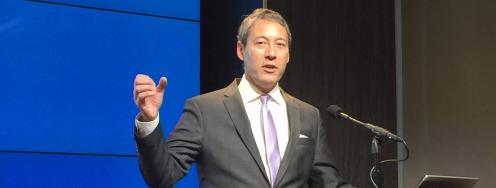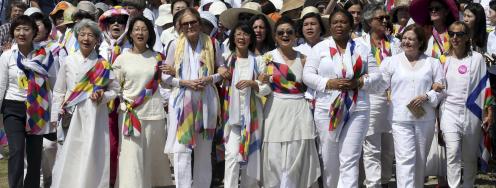Los Alamos National Lab Puts Profit Over Safety
On the radar: Los Alamos safety violations; Eliminating ICBMs won’t make us any less safe; Otto Warmbier’s death sets back hope of advances with North Korea; Four options for dealing with North Korea; President Moon looks to take lead in Korean strategy; Wednesday’s U.S.-China talks to focus on North Korea
Nuclear negligence at Los Alamos - “In mid-2013, four federal nuclear safety experts brought an alarming message to the top official in charge of America’s warhead production: Los Alamos National Laboratory, the nation’s sole site for making and testing a key nuclear bomb part, wasn’t taking needed safety precautions. The lab, they said, was ill-prepared to prevent an accident that could kill lab workers, and potentially others nearby,” write R. Jeffrey Smith and Patrick Malone for The Center for Public Integrity in an in-depth and wide-ranging article investigating nuclear negligence at Los Alamos National Laboratory.
--“The United States quietly shut down its sole facility [at Los Alamos National Laboratory] for testing and making the cores of its nuclear warheads in 2013 due to the inability of the facility’s managers to control safety risks there… The Energy Department paid Los Alamos National Laboratory more than $10 million in bonus profits last year for its work examining the safety and reliability of existing nuclear warheads, even though several of its efforts to test some of those warheads did not produce needed results.” Article here.
See also - “Safety lapses undermine nuclear warhead work at Los Alamos,” by Patrick Malone and R. Jeffrey Smith for The Washington Post here.
New nukes unnecessary, unaffordable - “Upgrading the oldest and most vulnerable of the legs of the triad—the land-based ICBMs—would be among most costly parts of the Trump administration’s military buildup. The good news is that the United States could get rid of this leg of the triad and not be any less safe,” writes Ivan Eland for Huffpost. “The same could be said of the aging U.S. nuclear-capable bomber force. In short, after the Cold War, the United States no longer needs all the 1,550 nuclear warheads allowed by the 2010 treaty on strategic weapons with Russia.”
--“Despite President Trump’s rhetoric, over time, he will not be able to afford unneeded defense profligacy, especially in nuclear weapons. The triad should be reduced to a ‘monad’ of submarines and their invulnerable ballistic missiles and maybe even to a level of such platforms and armaments that provide minimum nuclear deterrence.” For the full article, click here.
See also - Ploughshares Fund President Joe Cirincione talks ISIS and the U.S. on the fight for Syria, on The Bill Press Show this morning. Video here.
New Ploughshares Fund Report - Ploughshares Fund released a new report recommending that the United States rethink its strategy to buy new missile interceptors for Europe. Rather than field a new anti-missile system in Poland to counter Iranian intermediate-range missiles that do not exist, the report finds that the United States should put these plans on hold. “The expansion of U.S. anti-missile systems is Europe should be paused,” said report author Dr. Tytti Erästö, the Roger L. Hale Fellow at Ploughshares Fund. “This would pose no risk to NATO security, as there is no nuclear missile threat from Iran to justify the new defenses,” she said.
Student’s death sets back US-DPRK relations- “The death of a 22-year-old college student in Ohio on Monday has dashed any hopes of a quick detente between the U.S. and North Korea,” writes Andy Sharp for Bloomberg Politics. “The furor in the U.S. over Warmbier’s death recalls the raw emotions felt after a chemical weapons attack in Syria killed children, which prompted Trump to fire cruise missiles at Bashar al-Assad’s regime. Yet dropping bombs on Kim Jong Un’s nation -- an option Trump’s administration says is still on the table -- is so risky that many analysts see it as implausible.”
--“Trump’s administration has sought to pressure the 164 nations that have diplomatic ties with North Korea to downgrade or cut them. Nikki Haley, the U.S. ambassador to the United Nations, told countries last month: ‘You either support North Korea or you support us.’... The death may make it harder for South Korean President Moon Jae-in, who took power last month, to convince Trump of the benefits of greater engagement with North Korea.” For the full article, click here.
See also - “What Otto Warmbier’s Death Means for the United States’ North Korea Policy,” by Margaret Hartmann for New York Magazine here.
Considering options for North Korea - “As tensions flared in recent months, fanned by bluster from both Washington and Pyongyang, I talked with a number of national-security experts and military officers who have wrestled with the problem for years, and who have held responsibility to plan and prepare for real conflict,” writes Mark Bowden for The Atlantic. “From these conversations, I learned that the U.S. has four broad strategic options for dealing with North Korea and its burgeoning nuclear program.”
--Those options are: provoking a U.S. military strike to overthrow the Kim regime, limited conventional military attack, decapitation and acceptance. Bowden considers each option in considerable depth, stating from the outset that “all of them are bad.” He concludes on a note of macabre hope for a continued stalemate: “as a young man with a lifetime of wealth and power before him, how likely is [Kim Jong-Un] to wake up one morning and set fire to his world?” For the full article, click here.
See also - “Top North Korean Nuclear Negotiator Secretly Met With U.S. Diplomats,” by Jay Solomon for The Wall Street Journal here.
Seoul tired of Trump’s saber-rattling with DPRK - President Moon’s remarks on starting to say “no” to Washington, halting the deployment of the U.S. THAAD system in South Korea and his stated priority to focus on dialogue with North Korea “speak to Korea's dissatisfaction with the current stalemate caused by big power politics and illustrate Moon's intention to break from the current modus operandi of following the U.S.'s lead and try his hand independently,” writes the Editorial Board for The Korea Times.
--“Moon's position is clashing with the United States. The quixotic U.S. President Donald Trump is an aggravating factor but this can't explain what has gone wrong. Facing the North's growing missile and nuclear threats, the U.S. has its hands tied with few viable options. That may lead Washington to hand over the reins of a comprehensive Pyongyang policy to Seoul. This reset may be the solution to prevent the demise of the ROK-U.S. alliance as we know it, and find a new non-military way of dealing with a North Korea that is about to aim long-range nuclear missiles at the U.S. Now, the ball is in the U.S.'s court.” Full article here.
Tweet - @StanfordCISAC: .@SecDef19 discusses the paths for building peace w/North Korea. Video http://goo.gl/2kcCed & Q&A http://goo.gl/v8cNXf #NKpeace https://pbs.twimg.com/media/DCtKiB1U0AAXiag.jpg
See also - “Why South Korea Wants America To Take Backseat With North Korea” by Terrell Jermaine Starr for Foxtrot Alpha here.
DPRK dominating concern for bilateral talks - “China’s willingness to help rein in North Korea’s nuclear threat poses the biggest source of uncertainty in ties with the United States, as heightened tensions on the Korean peninsula look set to dominate a bilateral security gathering... on Wednesday,” write Chow Chung-yan and Shi Jiangtao for South China Morning Post. “‘The biggest risk for the relationship is potential disappointment [for Trump] over North Korea,’ Stephen Orlins, president of the National Committee on US-China Relations said. ‘Trump has decided the litmus test for US-China relations is if China can rein in North Korea. However, history suggests that China cannot control North Korea and Trump may be disappointed.’” For the full article, click here.
See also - “North Korea: Stark Limits to U.S.-Chinese Cooperation” by Thomas Cynkin for The Cipher Brief here.
Quick Hits
--“Banning the Bomb—A Blog of the Nuclear Weapons Prohibition Talks” by Alicia Sanders-Zakre for Arms Control Association here.
--“Revitalizing Internationalism through the Convention on the Prohibition of Nuclear Weapons” by Matthew Bolton for Just Security here.
--“Can women save the world?” by Elisabeth Eaves for the Bulletin of the Atomic Scientists here.
--“Prevent nuclear catastrophe: Finally end the Korean War” by Masako Ikegami for the Bulletin of the Atomic Scientists here.
--“The North Korea Instability Project: A New Approach to Eliminating North Korean Weapons of Mass Destruction Is Needed” by Robert Peters for 38North here.
--“Can China Actually Restrain Kim Jong-Un?” by Will Edwards for The Cipher Brief here.
--“Podcast: Is Kim Jong Un Ready to Talk to Donald Trump?” by Ben Pauker for Foreign Policy here.
--“What Would Happen in the Hours and Minutes After the US Bombed Iran?” by Mike Pearl for VICE News here.
--“How to Normalize Pakistan's Nuclear Program” by Gaurav Kampani and Bharath Gopalaswamy for Foreign Affairs here.
Events
--“Debate: North Korea’s Nuclear Program.” Co-hosted by Ploughshares Fund and the Center for Strategic and International Studies. The third in a debate series on a range of nuclear challenges and policy decisions the Trump administration will face in 2017. Tuesday, June 20, 2017 8:30p.m.-11:00p.m. EST (5:30p.m.-8:00p.m. local PST). David Brower Center, Goldman Theater, 2150 Allston Way, Berkeley, CA 94704. Details here.
--“There’s Something About Russia.” Hosted by the World Affairs Council. Tuesday, June 20, 2017, 6:00p.m.-8:00p.m. Horizon Ballroom, Ronald Reagan Building and International Trade Center, 1300 Pennsylvania Ave. NW Washington, D.C. 20004. Details here.
--“PONI 2017 Summer Conference.” Hosted by the Center for Strategic and International Studies. Wednesday, June 21, 2017, 11:30a.m.-Thursday, June 22, 2017 8:30p.m. EST (8:30a.m. June 21 - 5:30p.m. June 22 local PST). Lawrence Livermore National Laboratory, Center for Global Security Research. Details here.
--“The Changing Situation on the Korean Peninsula: Challenges for New Presidents in 2017." Hosted by Korea Economic Institute of America. Thursday, June 22, 2017, 8:00a.m-6:00p.m. Korea Economic Institute of America, 1800 K Street NW, Suite 1010, Washington, D.C. 20006. Details here.
--An Analysis of U.S. Missile Defense. Hosted by the Center for National Interest. Featuring Joe Cirincione, Tom Cotton and others. Monday, June 26, 2017, 12:00p.m. Center for National Interest, 1025 Connecticut Ave NW, Washington, D.C. 20036. Details to come.
--“Mission Accomplished? Challenges to Safety Culture in the Nuclear Weapons Complex” Hosted by the Carnegie Endowment for International Peace. Featuring Joyce Connery, Patrick Malone, Don Nichols, Toby Dalton and R. Jeffrey Smith. Thursday, June 29, 2017, 1:00p.m.-2:30p.m. Carnegie Endowment Headquarters, 1779 Massachusetts Ave NW, Washington, D.C. 20036. Details here.
--“Debate: U.S. Nuclear Weapons Modernization.” Co-hosted by Ploughshares Fund and the Center for Strategic and International Studies. Featuring Adam Mount, Hon. Ellen Tauscher and others. Thursday, June 29, 2017, 4:30p.m.-7:00p.m. CSIS Headquarters, 1616 Rhode Island Ave NW, Washington, D.C. 20036. Details here.



